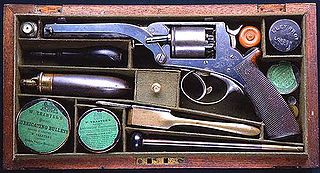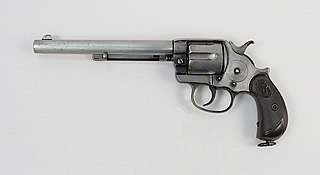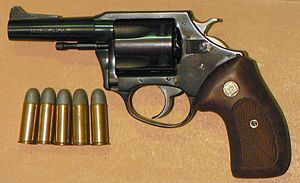
A revolver is a repeating handgun that has at least one barrel and uses a revolving cylinder containing multiple chambers for firing. Because most revolver models hold up to six cartridges, before needing to be reloaded, revolvers are commonly called six shooters or sixguns. Due to their rotating cylinder mechanism, they may also be called wheel guns.

The Colt Single Action Army is a single-action revolver handgun. It was designed for the U.S. government service revolver trials of 1872 by Colt's Patent Firearms Manufacturing Company and was adopted as the standard-issued pistol of the U.S. Army from 1873 until 1892.

The Desert Eagle is a single-action, gas-operated, semi-automatic pistol known for chambering the .50 Action Express, the largest centerfire cartridge of any magazine-fed, self-loading pistol.

Ethan Allen was a major American arms maker from Massachusetts. He is unrelated to the revolutionary Ethan Allen. His first firearm, the "Pocket rifle" was developed in 1836, and his first patent was granted in 1837.

Harrington & Richardson Arms Company is an American brand of firearms and a subsidiary of JJE Capital Holdings. H&R ceased independent production February 27, 2015.

The Ruger Blackhawk is a six-shot, single-action revolver manufactured by Sturm, Ruger & Co. It is produced in a variety of finishes, calibers, and barrel lengths.

Charter Arms Co. is an American manufacturer of revolvers. Since its founding in 1964, Charter Arms has produced revolvers chambered in the following calibers: .22 Long Rifle, .22 Winchester Magnum, .32 Long, .32 H&R Magnum, .327 Federal Magnum, .38 Special, .357 Magnum, 9×19mm Parabellum, .40 Smith & Wesson, .41 Remington Magnum, .44 Special, .45 ACP, and .45 Colt.

The GP100 is a family/line of double action five-, six-, seven-, or ten-shot revolvers made by Sturm, Ruger & Co., manufactured in the United States. Since its introduction, it has been produced with a number of variations including various barrel lengths and profiles, fixed or adjustable sights, and in blued carbon steel or stainless steel.

A snubnosed revolver is a small, medium, or large frame revolver with a short barrel, generally less than 4 inches in length. Smaller such revolvers are often made with "bobbed" or "shrouded" hammers and there are also "hammerless" models ; the point is to allow the gun to be drawn with little risk of it snagging on clothing. Since the external movement of the mechanism is minimal or nil, shrouded and hammerless models may be fired from within clothing. The design of these revolvers compromises range and accuracy at a distance in favor of maneuverability and ease of carry and concealment.

The Colt Detective Special is a six-shot, carbon steel framed, 2-inch (5.1 cm) or 3-inch (7.6 cm) barreled, double-action revolver, and the first example of a class of firearms known as "snubnose revolvers". Made by Colt's Manufacturing Company, this model revolver, as the name "Detective Special" suggests, was intended to be a concealed weapon used by plainclothes police detectives.

The Ruger Redhawk is a DA/SA, large-frame revolver introduced in 1979 by Sturm, Ruger & Company.

A handgun is a firearm designed to be usable with only one hand. It is distinguished from a long gun which needs to be held by both hands and braced against the shoulder. Handguns have shorter effective ranges compared to long guns, and are much harder to shoot accurately. While most early handguns are single-shot pistols, the two most common types of handguns used in modern times are revolvers and semi-automatic pistols, although other handguns such as derringers and machine pistols also see infrequent usage.

The Ruger Vaquero is a six-shot single-action revolver manufactured by Sturm, Ruger & Co. based on the New Model Ruger Blackhawk frame and was introduced in 1993. It comes in blued steel, case colored, and a gloss stainless finish, all of which are available with wood, hard rubber, simulated ivory or black micarta grips and fixed sights. It arose with the popularity of Cowboy Action Shooting from which came demand for a single-action revolver that was more traditional in appearance.

Introduced in 1907, the Colt Police Positive Special is a small-frame, double-action revolver with a six-round cylinder, primarily chambered for .38 Special. The Police Positive Special was intended primarily for sale to law enforcement agencies and enjoys the distinction of being Colt’s most widely produced revolver design, with over 750,000 built.

The Colt New Service is a large frame, large caliber, double-action revolver made by Colt from 1898 until 1941. Made in various calibers, the .45 Colt version with a 5½" barrel, was adopted by the U.S. Armed Forces as the Model 1909.

The Mossberg Brownie is a four shot, .22 Long Rifle pistol, similar to a derringer or pepperbox, produced by O.F. Mossberg & Sons from 1920 to 1932. The Brownie is based on an earlier pistol patented and licensed to the Shattuck Company by Oscar Mossberg.

The Rast & Gasser Model 1898 was a service revolver used by the Austro-Hungarian Army during World War I and various armies in World War II.

The Tranter revolver was a double-action cap & ball revolver invented around 1856 by English firearms designer William Tranter (1816–1890). Originally operated with a special dual-trigger mechanism later models employed a single-trigger mechanism much the same as that found in the contemporary Beaumont–Adams revolver.

The Colt M1878 is a double-action revolver that was manufactured by Colt's Manufacturing Company from 1878 until 1907. It is often referred to as the "Frontier" or the "Double Action Army" revolver. A total of 51,210 Model 1878 revolvers were manufactured, including 4,600 for the US Ordnance Department. These are known as the "Philippine" or "Alaskan" models.

The Medusa Model 47 is a revolver manufactured by Phillips & Rodgers Inc. of Huntsville, Texas, in the late 1990s. Based on the Smith & Wesson K frame, it is notable for being capable of chambering and firing approximately 25 different cartridges within the 9 mm caliber family, such as: .357 Magnum, .38 Special, .380 ACP, and 9×19mm Parabellum. While smaller diameter cartridges can be fired, accuracy suffers. The revolver was not a commercial success and the company that produced them ceased operations after just a few hundred units were made.





















